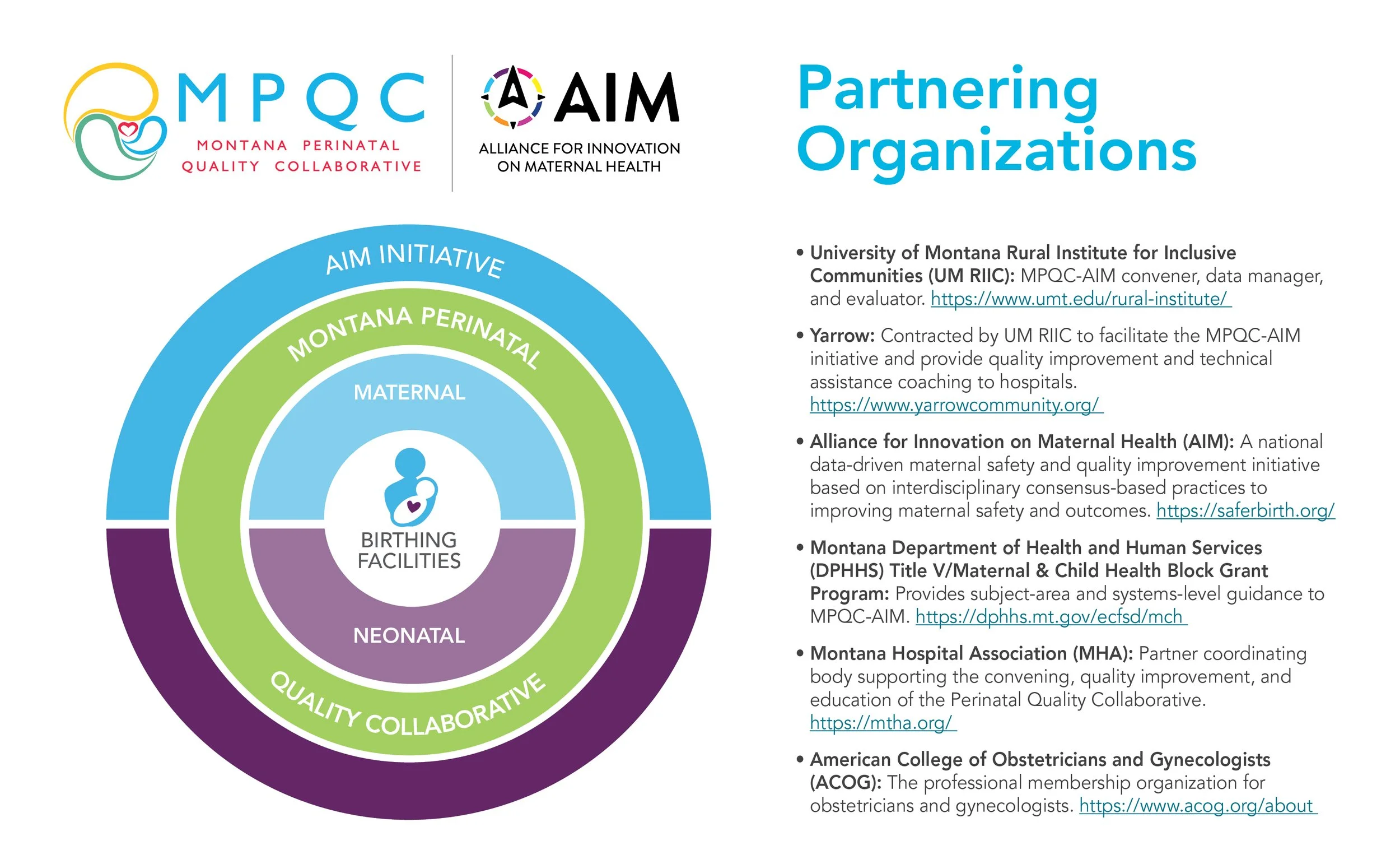ABOUT US
HISTORY
MPQC: The Montana Perinatal Quality Collaborative was established as a subset of the Montana Perinatal Association by a passionate group of volunteer maternal and infant care providers and public health professionals working to improve health outcomes for mothers and babies through continuous quality improvement. When initially founded, MPQC focused on neonatal health initiatives, such as the safe sleep project.
ABOUT MPQC-AIM
MPQC-AIM: With the support of the Health Resources and Services Administration (HRSA)’s funding through the Montana Obstetrics and Maternal Support (MOMS) program in 2021-2022, the MPQC’s Alliance for Innovation on Maternal Health (AIM) Obstetric Hemorrhage Patient Safety Bundle initiative was launched with 17 Montana birthing facilities. In 2022, the Centers for Disease Control and Prevention (CDC) awarded the University of Montana Rural Institute for Inclusive Communities a five-year, $1.375 million grant to support implementation of AIM Bundles through the same collaborative model with all willing facilities in the state. At this point, the MPQC-AIM arm of the MPQC was created to distinguish between the neonatal and maternal initiatives of the MPQC.
Target audience: The target audience for MPQC-AIM includes all providers and facilities that care for pregnant and postpartum patients in Montana that voluntarily commit to improve maternal health outcomes. In doing so, they are engaging with a growing community of hospitals, peers, and local, state, and national partners dedicated to continuously improving maternal safety and healthcare quality.
Partners: MPQC-AIM has received support and partnership from the following organizations: Montana Department of Public Health & Human Services (DPHHS), Montana Hospital Association (MHA), Montana Perinatal Association (MPA), the Montana branch of the Association of Women’s Health, Obstetric, and Neonatal Nurses (AWHONN), Montana Primary Care Association (MPCA), the Montana Section of the American College of Obstetricians and Gynecologists (ACOG), the Montana State University Mark & Robyn Jones College of Nursing (MRJCON), Montana Pregnancy Risk Assessment Monitoring System (PRAMS), Montana’s Maternal Mortality Review Committee (MMRC), and the Institute on Healthcare Improvement.
MPQC-AIM QUALITY IMPROVEMENT PROCESS
The Breakthrough Series Model: The MPQC-AIM quality improvement process is modeled after the Institute for Healthcare Improvement (IHI) Breakthrough Series Collaborative Model for Breakthrough Improvement. “The Breakthrough Series was designed to help organizations close that gap between cost and quality by creating a structure in which interested organizations can easily learn from each other and from recognized experts in topic areas where they want to make improvements.” [1]
This approach is used to generate collaboration, shared learning, and support to give hospital teams the momentum needed to use their locally relevant methods and resources for improvement to fully integrate the AIM Bundle components. This will result in a facility-specific standardized approach to reduce risk and improve outcomes for each collaborative initiative and will enable hospital teams to sustain the structures and processes they have developed within their units to continuously improve upon their standardized approach to readiness, recognition & prevention, response, and reporting/systems learning outlined by the AIM Bundles.
Pre-work: Pre-work is the period between a hospital’s commitment to participate and the Collaborative’s first Learning Session. During this time, the Learning Collaborative team, project champions, and hospital improvement teams work to develop and strengthen the needed structures for collaborative improvement.
Learning Sessions: Learning Sessions are virtual meetings that bring together the multidisciplinary improvement teams from each participating hospital and expert faculty to exchange ideas about the topic and specific changes outlined in the bundle as well as the Model for Improvement. The Learning Sessions include time for each hospital’s team to work together to integrate learning and plan for how to immediately incorporate learning into their improvement processes. There are three Learning Sessions conducted during the Learning Collaborative. Teams progressively learn more from each other in each Learning Session through dynamic scheduled sessions and activities, and through informal networking and dialogue.
Action Periods: Action Periods are the time between Learning Sessions, when hospital improvement teams use the Model for Improvement to implement small, rapid-cycle, PDSA tests of change. The impact of those changes is then evaluated with measures including those in the Learning Collaborative’s Measurement Strategy (outlined in further detail in each Bundle’s Implementation Packet). Participating hospitals submit data measures quarterly to the data team at the University of Montana Rural Institute for Inclusive Communities (UM RIIC). UM RIIC creates and shares individualized facility reports to be shared back with facility teams, and aggregate reports to be shared amongst the Learning Collaborative. Improvement teams are supported during Action Periods by conference calls, interactive web-based discussions, online sharing platforms, site visits, coaching, and mentoring to enable them to learn from state and national experts as well as from other hospital improvement teams across Montana.
Model for Improvement: In addition to the foundational structure of the Breakthrough Series and the guiding standardization of AIM Patient Safety Bundles, the Learning Collaborative will use the Model for Improvement as a structured approach used by teams to drive improvement. The Model for Improvement is based on IHI’s three pivotal questions in addition to the traditional PDSA cycle, utilizing time-based aims alongside process and outcome measures to track improvement and evaluate progress. PDSAs initially test changes on a very small scale to quickly identify promising ideas, and then incrementally scale up improvements based on rapid cycle testing and learning to adapt and develop changes into robust and reliable standard processes. MFI stresses prediction and measurement as critical features of change evaluation and includes an array of techniques to help guide the journey from change innovation to prototyping, to implementation and spread.
[1] Resar, R., Griffin, F., Haraden, C., & Nolan, T. (2012). Using care bundles to improve health care quality [white paper]. Institute for Healthcare Improvement. http://www.ihi.org:80/resources/Pages/IHIWhitePapers/UsingCareBundles.aspx
[2] Institute for Healthcare Improvement. (2003). The breakthrough series: IHI’s collaborative model for achieving breakthrough improvement [white paper]. Institute for Healthcare Improvement. https://www.ihi.org/resources/Pages/IHIWhitePapers/TheBreakthroughSeriesIHIsCollaborativeModelforAchievingBreakthroughImprovement.aspx


